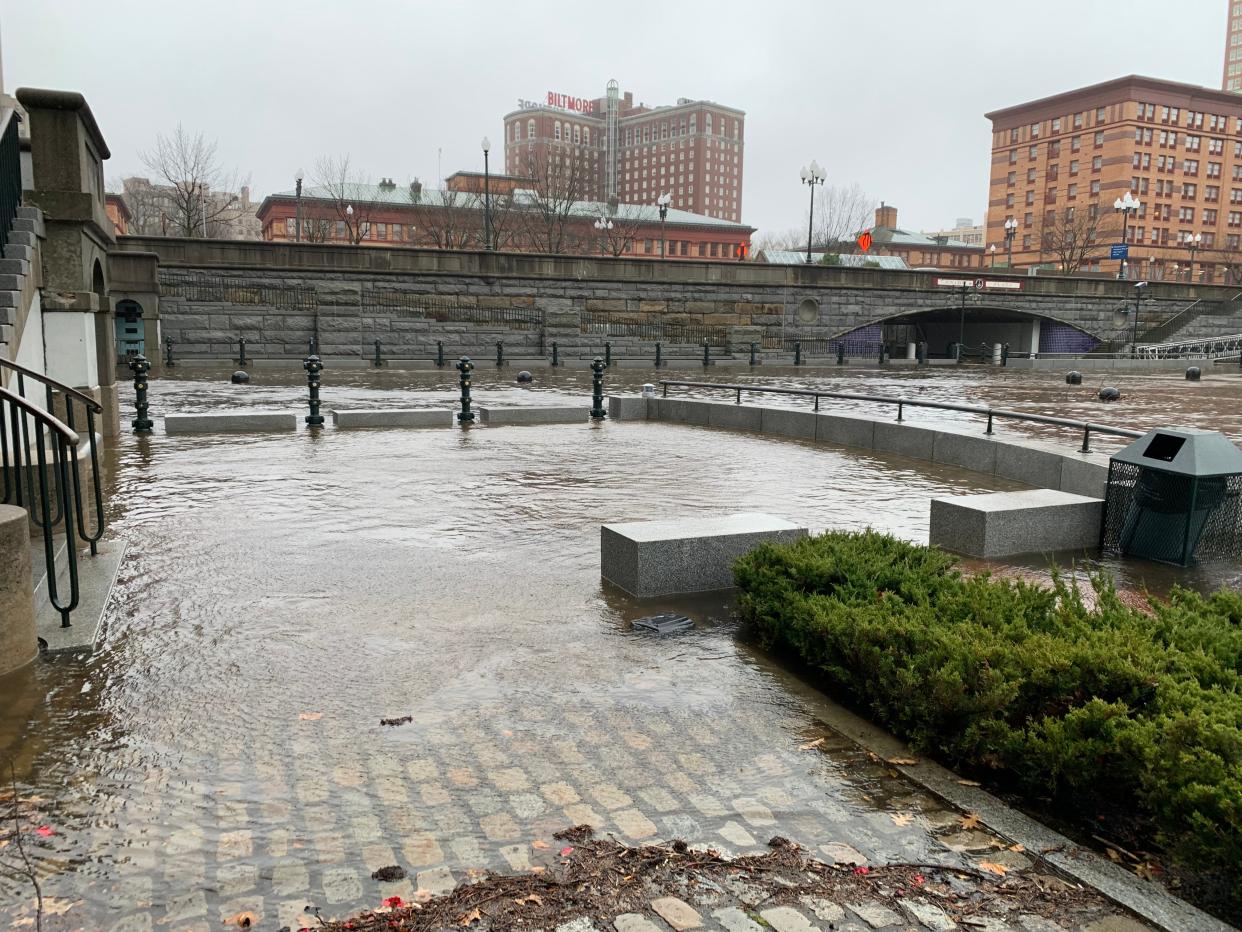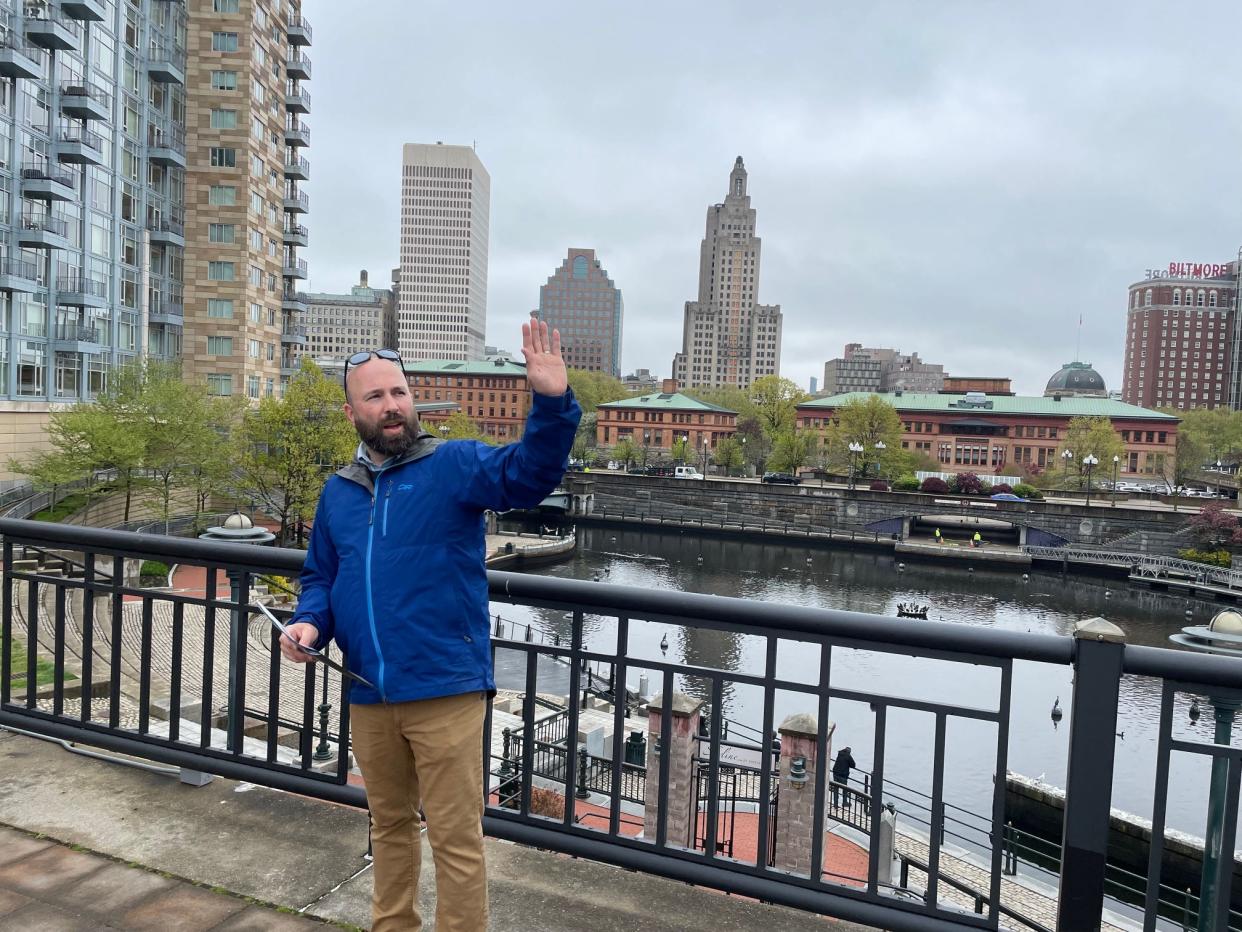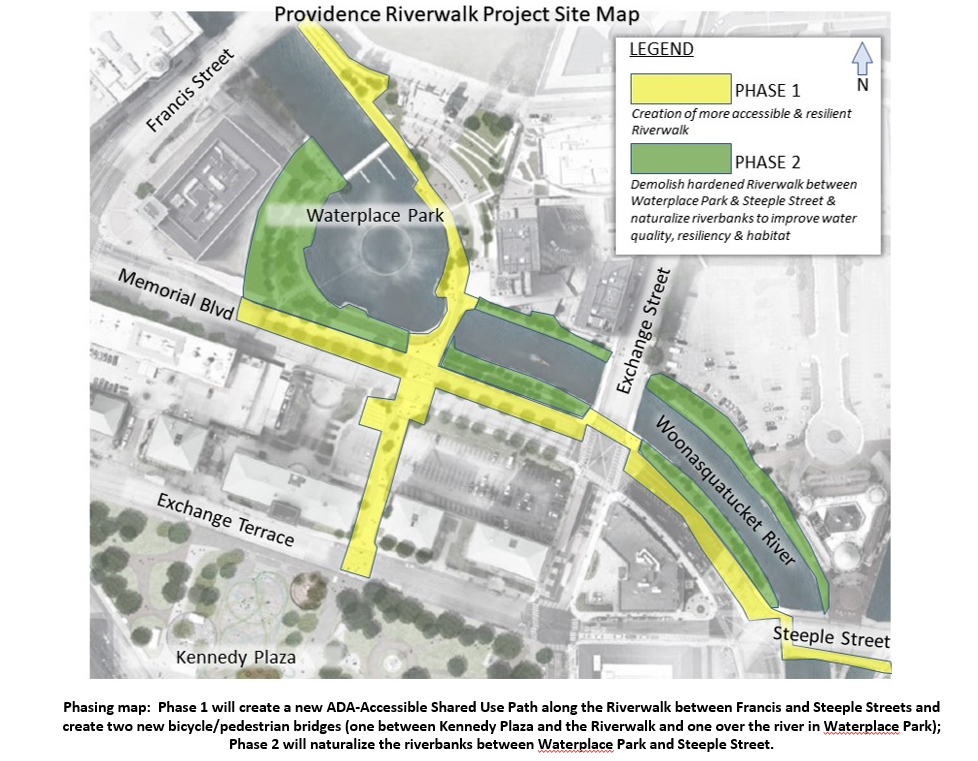At Waterplace Park, stone and concrete will be replaced by natural riverbank. Here's how.
PROVIDENCE – Waterplace Park was never supposed to be under water.
But when the rains are heavy enough or the tides are unusually high, the Woonasquatucket River spills over the park’s concrete-and-stone banks, sending floodwaters coursing across the walkways that encircle the basin and into the pedestrian tunnel under Memorial Boulevard.
As climate change pushes sea levels higher and ramps up the frequency of extreme downpours, city officials know they can’t control the waters entirely, but they hope a major improvement project will help ease the impacts of flooding on the 4-acre park in the heart of downtown that also includes the Riverwalk.

What will the redesign of Waterplace Park look like?
The plan is to tear out sections of the manmade walls that contain the river between Waterplace Park and Steeple Street and replace them with more natural dirt banks covered in plants and trees.
Raised walkways would be built above the new green spaces so people would still be able to stroll along the river.
![This rendering of the Waterplace Park project shows how the city plans to restore the natural riverbanks while preserving standing and sitting space for events [City of Providence/contributed photo]](https://s.yimg.com/ny/api/res/1.2/1.rcWF1NZbPLuOH3LaEZJw--/YXBwaWQ9aGlnaGxhbmRlcjt3PTEyNDI7aD04Njg-/https://media.zenfs.com/en/aol_gannett_aggregated_707/fd16039aa4614948a4c62e1941ecf535)
The vegetated riverbanks would be designed to withstand periodic flooding from the river, just as they do in more natural areas. And they would also help with mitigate flooding by absorbing runoff from surrounding streets – which can be contaminated with heavy metals or oils and would otherwise flow into the river and on to Narragansett Bay.
“We’re not going to be able to stop this area from flooding,” Chris Martin, principal planner with the City of Providence, said on a recent tour of the area with federal officials. “I think this is about making the area as resilient as possible so it can take that flooding.”
Flooding has increased around the park
For decades, long stretches of the Woonasquatucket, Moshassuck and Providence rivers were hidden away, covered by roads, railroad tracks and expanses of surface parking.
The city reclaimed the downtown riverfront by relocating infrastructure and carving out public space along the water. Completed in 1994, the urban park has since become most closely associated with WaterFire, the periodic public art festival centered around braziers set aflame in the rivers.
The new plan to remake the park would continue the work to restore the rivers by bringing them even closer to their natural state.
The plans are being funded by $2 million in city money, $7.8 million from the federal Department of Transportation and $1 million from the National Coastal Resilience Fund, which is going toward the climate adaptation part of the project.

“Part of our national mission is protecting lives and property from the impacts of climate change,” said Rick Spinrad, administrator of the National Oceanic and Atmospheric Administration, one of the partners in the coastal resilience fund. “This is an excellent case study in how we do that.”
Sea levels in Providence have risen by about 10 inches over the last century, and the rate of increase has picked up as waters heat and expand, ocean currents slow and glaciers melt.
The impacts are most acutely felt during so-called king tides, which occur a half-dozen or so times a year when the moon is new or full and when it’s at its closest point to Earth on its elliptical orbit. At those times, the moon’s gravitational pull is strongest and the tides reach extreme highs and lows.
From 2019 to 2022, the most recent year for data, the Providence area had between 5 and 8 days annually of tidal flooding, compared to the cumulative average of 3 days in 2000, according to NOAA.
Climate improvements are part of bigger project to revamp the park
The work to adapt the park to climate change is part of a larger project to make it more accessible and welcoming to the public.
Right now, it’s difficult, if not impossible, for some people with disabilities to use the space. Parts of the park can only be reached by stairs. The paths leading from the tidal basin to Steeple Street are bumpy, narrow in places, and can be tricky to navigate.
The new elevated walkways would be wider and have more open seating areas. They’d also slope down from street level so people in wheelchairs would be able to use them.
The plan also calls for construction of a bike and pedestrian bridge from Exchange Terrace over the parking lot behind the former Union Station building. It would connect to Memorial Boulevard, where there would be a crossing for people to enter the park.
When will the work be done?
The project is still in the planning stages and Martin expects it will take another two and a half years for the engineering and design to be completed.

Early estimates of the plan in 2021 that also included improvements to Kennedy Plaza put the total costs at $140 million. Michaela Antunes, a spokeswoman for the city, said a lot has changed with construction costs since then.
“Work done under the scope of the engineering and design of the Riverwalk project will involve finalizing cost estimates for future construction,” she said in an email.
Some smaller improvements related to the plan are already being implemented. City crews have removed bollards and taken out other obstructions in the tunnel under Memorial Boulevard to open up sight lines in an effort to improve safety.
They’ve also installed a new artistic lighting system inside the tunnel that will change colors in commemoration of cultural festivals and other events.
Park project also aimed at keeping rivers clean
Officials hope that improvements to the rivers will also help bring more people to the park.
The waters in upper Narragansett Bay, which include the Providence River, are the cleanest they’ve been in generations. The improvements are largely due to the construction of enormous tunnels to store runoff and sewage during heavy storms.
The creation of rain gardens and retention areas that can capture stormwater and allow it to percolate into the ground – types of green infrastructure similar to what’s being planned along the riverbanks – have also made a big difference throughout the 51-square-mile Woonasquatucket River watershed.
As has dredging the river to remove garbage and accumulations of road sand that clogged up the tidal basin.
“The cleaner water is a big part of the story here,” said Janet Coit, head of NOAA Fisheries and former director of the state Department of Environmental Management. “It can attract people back for recreation.”
This article originally appeared on The Providence Journal: Waterplace Park in Providence will go back to nature in major makeover
